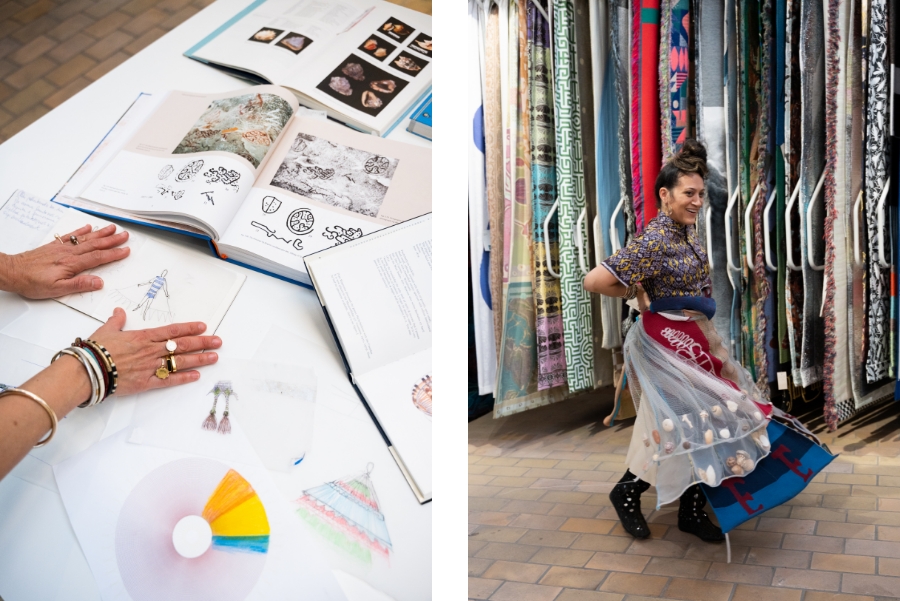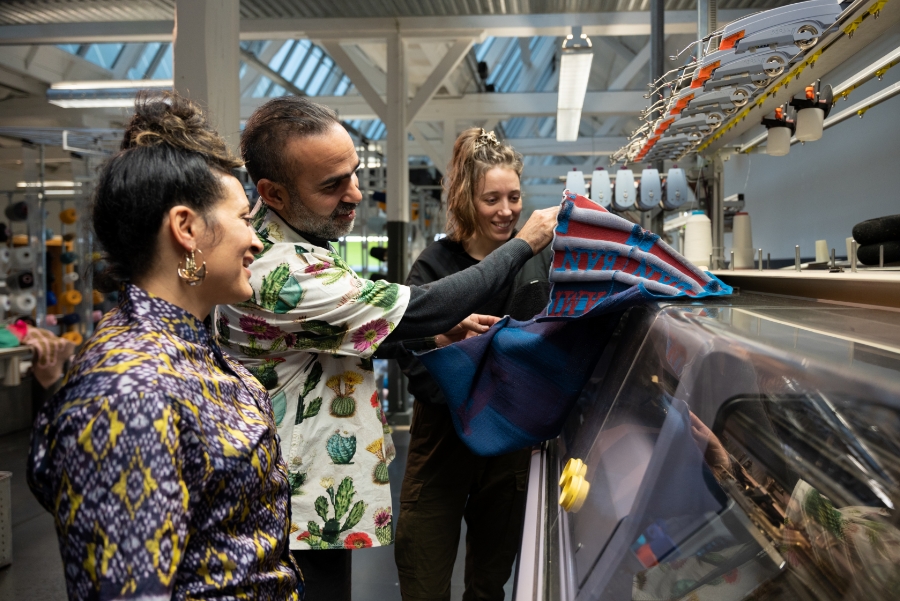Textile now – each thread tells a story, an exhibition showcasing spectacular works from the TextielLab, opens on 10 June. One of these works is ‘Dilanti di Biento’, by the Aruban artists Alydia Wever and Ryan Oduber. This layered installation, made partly on the knitting machine and partly on the plaiting machine, visualises their search for identity and connection.
Small bottles of Caribbean seawater, silver spoons with a cowrie shell, pebbles from their garden in Aruba, shells from the beach, Antillean lollipops, copper boxes, Delft blue figurines and much more: Alydia Wever and Ryan Oduber use these personal mementos to tell the story of the island where they grew up and met in 2006. Assisted by passementerie expert Veva van der Wolf and three interns, the duo made 120 spools from these items on the plaiting machine. Over the course of two days, the treasures were plaited with different yarns – from monofilament and paper yarn to linen and recycled PET – in such a way that they are still recognisable. They now adorn the hem of the three bell skirts that make up ‘Dilanti di Biento’. On 10 June, the mannequin wearing the dress will start her traditional dance during Textile now. The mannequin begins to move when someone approaches, performing a choreography that gracefully fans out the dress. ‘Dilanti di Biento’ translates as ‘faster than the wind’, a title that touches on universal themes. “Our energy is always in motion,” says Wever. “Life is like a dance, and it’s over in a flash.” Oduber adds, “You don’t actually have much time to discover who you are.”

Alydia Wever & Ryan Oduber are working on “Dilanti di Biento” in the TextielLab. Photos: Patty van den Elshout
Intertwined emotions
The layered installation explores identity and connection. The dress’ design is based on the hammocks that are so characteristic of the Caribbean. Originating from Colombia and Venezuela, and made a stone’s throw from Aruba by the indigenous people of La Guajira, this everyday item symbolises the network of genes that the people here carry within them. Both the motifs and the cords connecting the skirts are derived from a hammock. At the top, the cords come together in a headband, with which the wearer holds up the costume. The duo worked with Veva van der Wolf to design a hammock, which they then gave their own plaited interpretation. “The emotion and spirituality that Alydia and Ryan put into their work give it extra body and meaning,” says Van der Wolf. “It’s wonderful to see how their energy permeates their work.” Product developer Serena Huizinga, who supervised the knitting of the bell skirts, agrees: “Working with them was very special. It was a challenge to incorporate all their ideas into the knit; we had to skip a lot. But it has nevertheless become a rich work with a lot of emotional resonance.”

Alydia Wever and Ryan Oduber in conversation with product developer Serena Huizinga. Photo: Patty van den Elshout
Knitted fishing nets
The skirts were knitted on the flat knitting machine, using shortened rows to achieve the bell effect. The bottom layer, made with a mix of blue and red-brown yarns, represents the clay soil in Aruba. Texts in Papiamento knitted into the fabric translate as ‘the soul longs to speak to me’ and ‘celebrating as we go down’, expressing the tragedy of a young post-colonial nation. The second and third layers fall over the first layer like semi-transparent fishing nets. Little bags containing shells and pieces of coral were knitted into the transparent white monofilament, in reference to the endless white beaches that mainly draw the Dutch to Aruba these days. The monofilament is alternated with bands of wool, cotton and viscose – jacquard knits featuring an ancient cave drawing and images of local flowers and plants, such as cacti, aloe vera, hibiscus and kibrahacha.
“The skirts, cords and spools represent the fibres of our existence.”
Unravelling DNA
Through all these personal and cultural mementos, Alydia and Ryan not only celebrate their Aruban roots, but they also make the legacy of colonialism tangible and aim to bring Caribbean and Dutch culture closer together. Specially for this assignment, they unravelled their own DNA and incorporated as many elements of it as they could into the work. The unique combination of knitting and passementerie made this possible: “The knitted skirts, the cords that connect them and the plaited spools represent the fibres of our existence.”